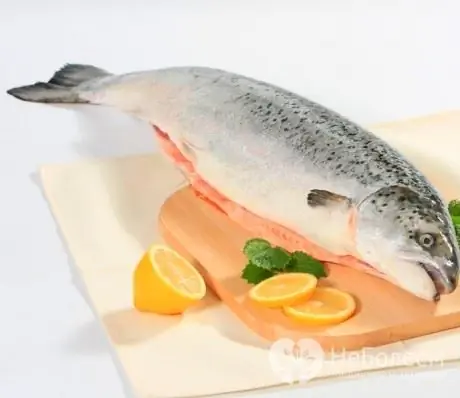- Author Rachel Wainwright [email protected].
- Public 2023-12-15 07:39.
- Last modified 2025-11-02 20:14.
Salmon
Salmon belongs to the salmon family. This is a rather large fish, some individuals of it reach a length of 1.5 m and a weight of 39 kg. The salmon is covered with small silvery scales on the outside, there are no spots on its surface below the lateral line, but during spawning (September-November), red and orange spots appear on the head and sides.
The ratio of BJU in the product

Source: depositphotos.com How to burn 208 kcal?
| Walking | 52 minutes |
| Jogging | 23 minutes |
| Swimming | 17 minutes |
| A bike | 30 minutes. |
| Aerobics | 42 minutes |
| Household chores | 69 minutes |
Salmon live in the Atlantic and Arctic Oceans, in the Baltic Sea, feeding on crustaceans and other fish. For spawning, she swims into rivers. The fish is sexually mature at the age of 5-6 years. In rivers, each individual lays from 6 to 25 thousand large orange eggs, from which juveniles emerge. Young fish live in rivers for up to 5 years, and then go to sea. Salmon lifespan up to 9 years.
For people, this type of fish is of high commercial value, its red meat is very tasty and healthy.
The benefits of salmon
The meat of this fish can be included in the diet of both adults and children. And although there are many different ways to cook salmon, the maximum amount of nutrients is preserved when baked in foil.
The calorie content of salmon is 2 times higher than white fish. Red fish meat is an easily digestible source of protein and essential amino acids; 100 g of the product contains up to half of the daily protein intake.
The benefits of salmon for the body are determined by its fats, which consist of polyunsaturated fatty acids. They are easily digested and, unlike animal fats, are very useful, especially for preventing blood clots, cardiovascular diseases, and for improving blood flow through the smallest capillaries.
Regular consumption of salmon improves the functioning of the digestive tract, liver, nervous system, elasticity of the walls of blood vessels, and increases resistance to infections. Slightly salted salmon contains substances that prevent thrombophlebitis (inflammation and thrombosis of the veins).
This fish improves mood and relieves nervous tension, helps to quickly restore brain performance after exhausting work.
The benefits of salmon for pregnant women are that it is an irreplaceable source of protein for the unborn child, and omega-3 fatty acids, which are involved in building the fetal brain.
With a regular lack of polyunsaturated fatty acids in the diet, atherosclerosis, rheumatoid arthritis, cancer, and immunodeficiency develop more often.
In addition to omega-3 fatty acids, which have anti-inflammatory properties, salmon are rich in magnesium, and therefore may be useful in preventing bronchial asthma attacks. According to scientists, magnesium deficiency may be one of the provoking causes of asthma.
According to some reports, salmon has a positive effect on the course of psoriasis, on the work of the brain and eyes.
Fish is rich in vitamins A, B and D, fish oil can lower blood cholesterol and increase protein absorption. There are many useful microelements in salmon, iodine and selenium are especially valuable for the human body.
The calorie content of salmon is 220 kcal per 100 g of product.
Cooking salmon
On sale most often you can find fresh and frozen salmon, as well as lightly salted and smoked - ready-to-eat. The smell of fresh fillets should not have a pronounced fishy tint, the structure of fresh fish is firm and elastic.
Cooking salmon is not a complex and time-consuming procedure. The excellent taste of fish is preserved in simple dishes, and it is rightfully referred to as fish delicacies.
You can grill salmon, bake in foil. It is not recommended to fry this fish, since in this case almost all nutrients will be destroyed. That is why connoisseurs of this fish prefer to smoke or salt it. If the salmon is purchased in a store in a vacuum package, it can be stored for up to 2 months from the date of packaging. When the package is opened, the shelf life is reduced to 1-1.5 days.

To cook lightly salted salmon, you should cut it into fillets, roll each piece in salt and put under pressure, shifting the pieces during ripening for even salting, in a day the fillet is ready for use, and does not require additional cooking. The most difficult thing in cooking lightly salted salmon is to cut the fillet. This fish is great for salads, omelets, canapes.
To bake the salmon in the oven, the fish is peeled from the scales, cut into steaks, the bones are removed and rolled in a mixture of dill and salt. To make the fillet soaked better, let it stand for about half an hour. Then the fish is sprinkled with fresh lemon juice, wrapped in foil and placed in an oven preheated to 180 degrees for 30 minutes. Such a dish is very useful and can be a decoration for any festive table. The high calorie content of salmon combined with delicate taste and aroma will satisfy the most demanding appetite.
Contraindications
Salmon is not recommended to eat if allergic reactions have been noted on it before. Most often this happens if you eat salmon, in the preparation of which preservatives and dyes were used.
YouTube video related to the article:
Found a mistake in the text? Select it and press Ctrl + Enter.






